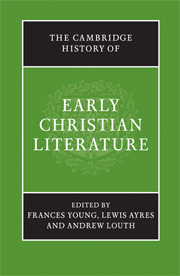Book contents
- Frontmatter
- PART ONE The Beginnings: The New Testament to Irenaeus
- A LITERARY GUIDE
- 1 Introduction: the literary culture of the earliest christianity
- 2 The apostolic and sub-apostolic writings: the New Testament and the Apostolic Fathers
- 3 Gnostic literature
- 4 Apocryphal writings and Acts of the martyrs
- 5 The Apologists
- 6 Irenaeus of Lyon
- B CONTEXT AND INTERPRETATION
- PART TWO THE THIRD CENTURY
- PART THREE FOUNDATION OF A NEW CULTURE: FROM DIOCLETIAN TO CYRIL
- Bibliographies
- Index
- Map: The Roman Empire in the late fourth century AD"
- References
1 - Introduction: the literary culture of the earliest christianity
from A - LITERARY GUIDE
Published online by Cambridge University Press: 28 March 2008
- Frontmatter
- PART ONE The Beginnings: The New Testament to Irenaeus
- A LITERARY GUIDE
- 1 Introduction: the literary culture of the earliest christianity
- 2 The apostolic and sub-apostolic writings: the New Testament and the Apostolic Fathers
- 3 Gnostic literature
- 4 Apocryphal writings and Acts of the martyrs
- 5 The Apologists
- 6 Irenaeus of Lyon
- B CONTEXT AND INTERPRETATION
- PART TWO THE THIRD CENTURY
- PART THREE FOUNDATION OF A NEW CULTURE: FROM DIOCLETIAN TO CYRIL
- Bibliographies
- Index
- Map: The Roman Empire in the late fourth century AD"
- References
Summary
The last 200 years have seen considerable swings in the literary assessment of the earliest Christian literature, including as it does the texts which became the canonized Scriptures of the Church, but not just those. The pendulum has been affected partly by new discoveries, but changing perspectives have also played their part. A series of interrelated questions has emerged from the principal debates:
(1) In what sense are Christian texts ‘literary’? How do they relate to other literature that has survived from antiquity?
(2) Which texts should be included in the category ‘Christian’?
(3) From what social level and cultural milieu did these texts issue? To what extent are they to be assessed as the deposit of an oral and non-literary environment? How is the transition to written texts to be evaluated?
(4) Do peculiarities of language, rhetoric or genre set these texts apart? Or are they typical of the time and circumstances from which they emerged?
(5) How are these texts to be read? Is it enough to evaluate them as historical documents, relating them to the historical circumstances in which they were generated and the literary culture to which they originally belonged?
Some of these questions will be considered in Part I B, but it is an illusion to think that a description of the literature can be offered without essaying some answers.
Keywords
- Type
- Chapter
- Information
- The Cambridge History of Early Christian Literature , pp. 1 - 10Publisher: Cambridge University PressPrint publication year: 2004

